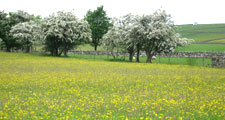Middle Dale
Land Management
Natural Features, Watercourses and Wetlands
- Protect river banks, gills and ravines from stock to encourage regeneration of semi-natural gill and riparian woodland.
Farmland
- Conserve species rich hay meadows – avoid ploughing and reseeding, herbicide and fertiliser applications. Time cutting and grazing regimes to promote flowering and seed setting.
- Restore former meadows by reseeding and/or the use of hay crops from local meadows as a seed source.
- Manage semi-improved pastures to enhance their biodiversity by adopting appropriate stocking levels and avoiding further improvements such as drainage, ploughing and reseeding. Limit the use of fertilisers and herbicides.
Trees, Woodlands and Forestry
- Conserve, restore and extend gill and riverside woods by fencing and excluding livestock to promote natural regeneration.
- Plant new native oak-birch, ash and alder woodlands in gills and ravines, along river banks and streamsides, around dale floor reservoirs and on steep daleside bluffs.
- Increase the proportion of locally native species when restocking plantations.
- Conserve and reinforce stands of shelter trees around daleside farms.
- Conserve existing field trees and protect them from livestock where necessary. Plant new field trees (Ash, Oak, Sycamore) where they are characteristic.
Cultural Features
- Protect archaeological features by avoiding overstocking or supplementary feeding on sensitive sites.
- Protect and conserve lead mining remains – avoid physical damage, removal, infilling or tree planting.
- Restore or consolidate important structures and gate open shafts and adits taking archaeological advice.
- Conserve and maintain historic field barns, farm buildings and lime kilns.
- Conserve and enhance old quarries by avoiding tipping and excluding livestock to promote natural regeneration. Maintain access to geological exposures
Field Boundaries
- Maintain and restore dry stone walls. Restore roadside walls where they are damaged or derelict and reinstate them where they have been removed.
Development
Agricultural buildings
- Site new farm buildings close to existing buildings where possible, and reflect their scale, character and materials.
- Reduce the impact of larger modern buildings by careful selection of colour, breaking up mass and planting screening belts of native species. Follow the North Pennines AONB Agricultural Building Design Guide.
Energy and Infrastructure
- Avoid the siting of tall structures such as masts, pylons and wind turbines in the Middle Dale landscape generally.
- Where masts, pylons or domestic scale wind turbines are needed, site them close to existing buildings or woodland edges and avoid sensitive skylines. Where possible use underground services.
Minerals and Waste
- Avoid damage to sensitive natural landforms.
- Avoid extraction on prominent daleside slopes, or breaching local skylines with extraction areas or storage mounds.
- Restore quarry faces to naturalistic profiles using restoration blasting.
- Restore quarries to semi-natural woodland, grassland, wetland and bare rock habitats using natural regeneration where appropriate.
Tourism and Recreation
- Tourism and recreational development should be undertaken in such a way as to avoid any urbanising influence on the landscape. Existing buildings should be re-used where possible. New buildings should reflect the scale, form, materials and vernacular detailing of traditional farm buildings in the area.
- Facilities and infrastructure for tourism and recreation – paths, car parks, litter bins, signage and interpretation – should be provided only where absolutely necessary, and should be sensitively designed and low key to avoid exerting an urbanising influence on this very rural landscape.
Further Information
Broad Landscape Types Guidelines



